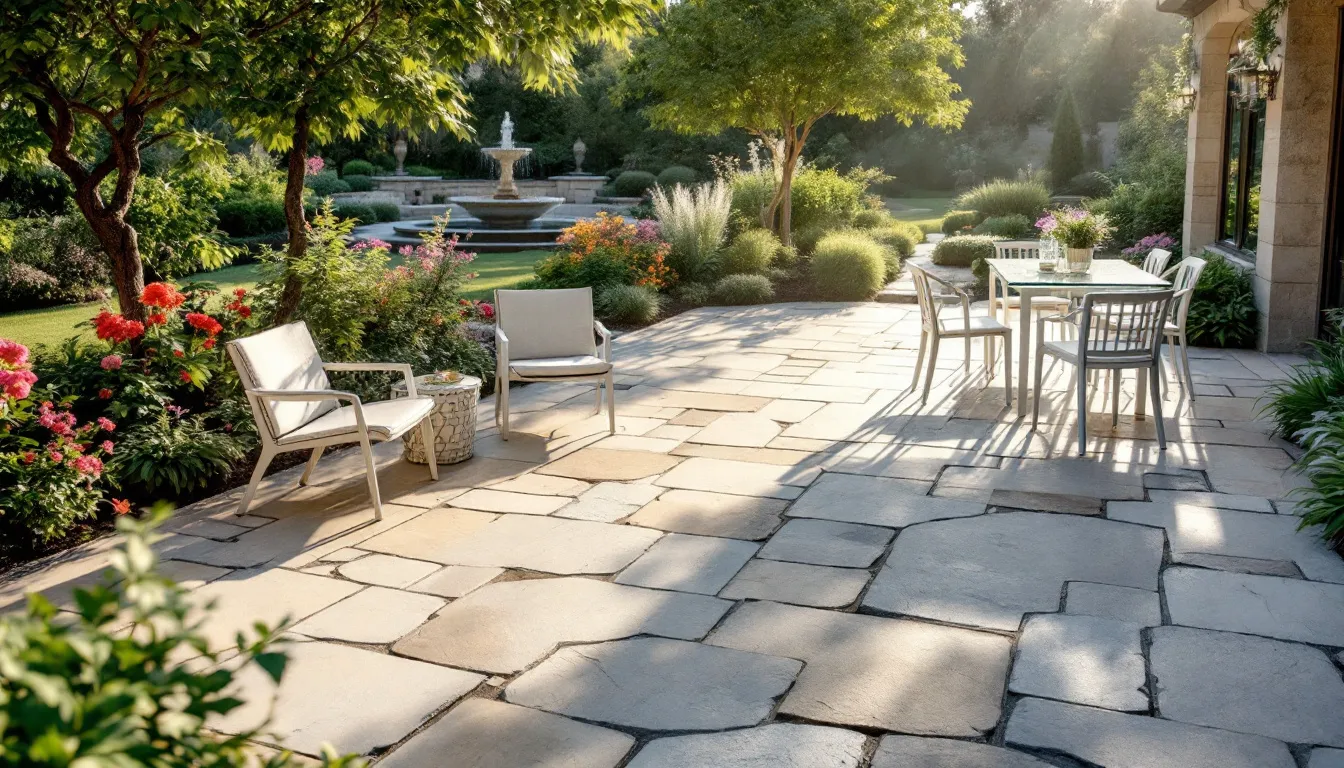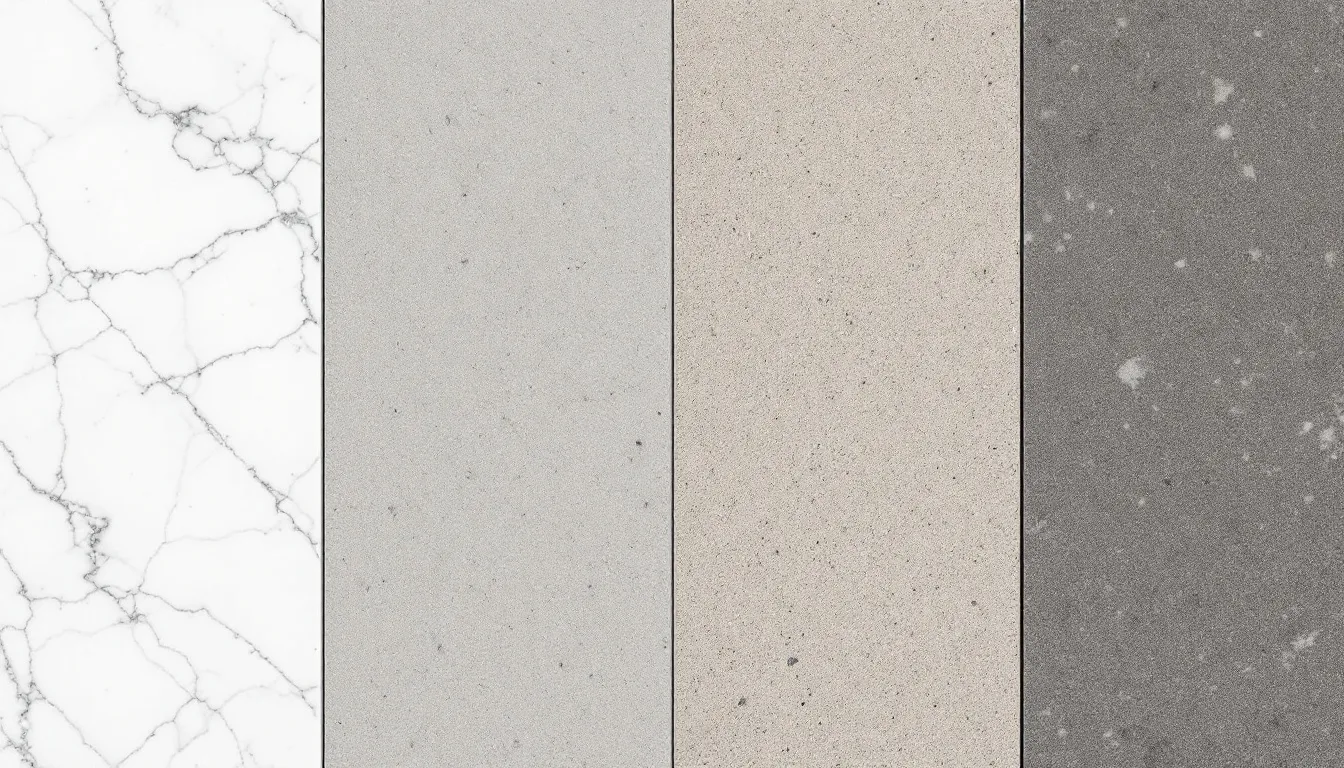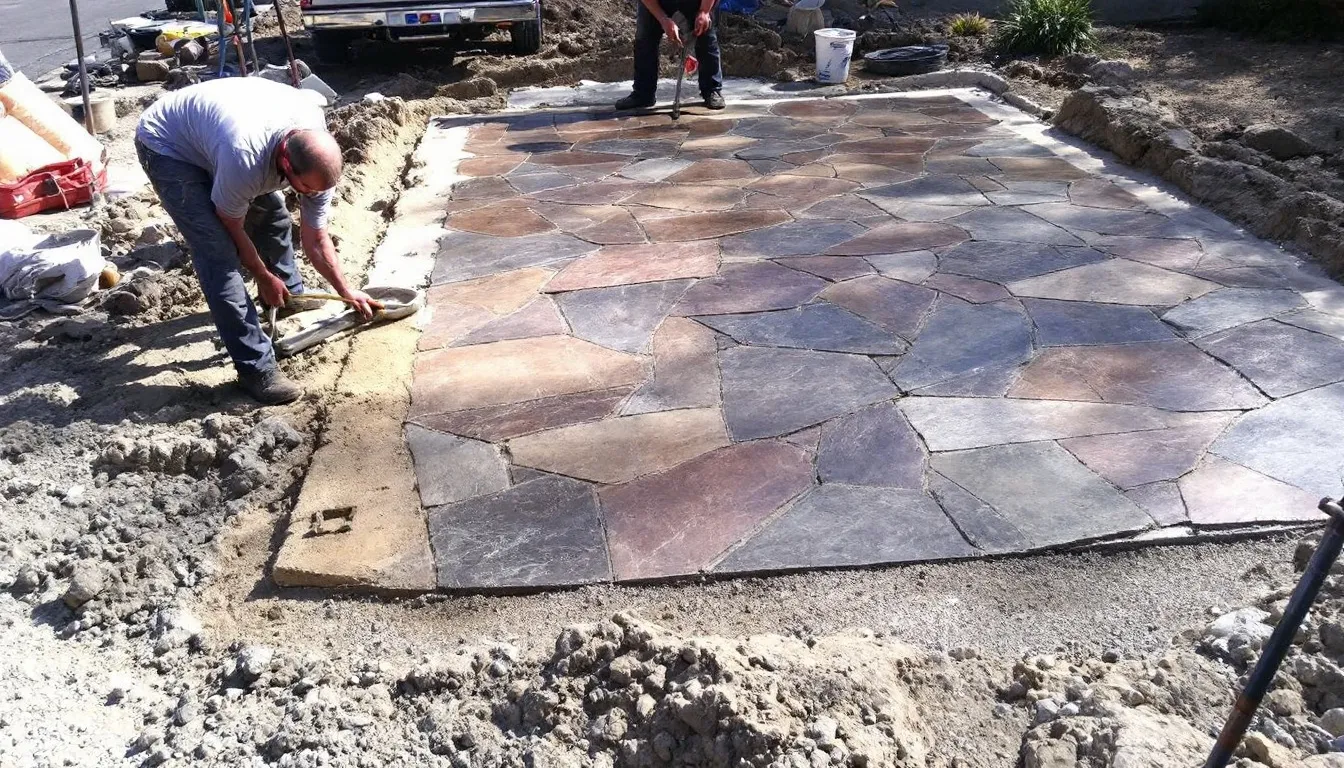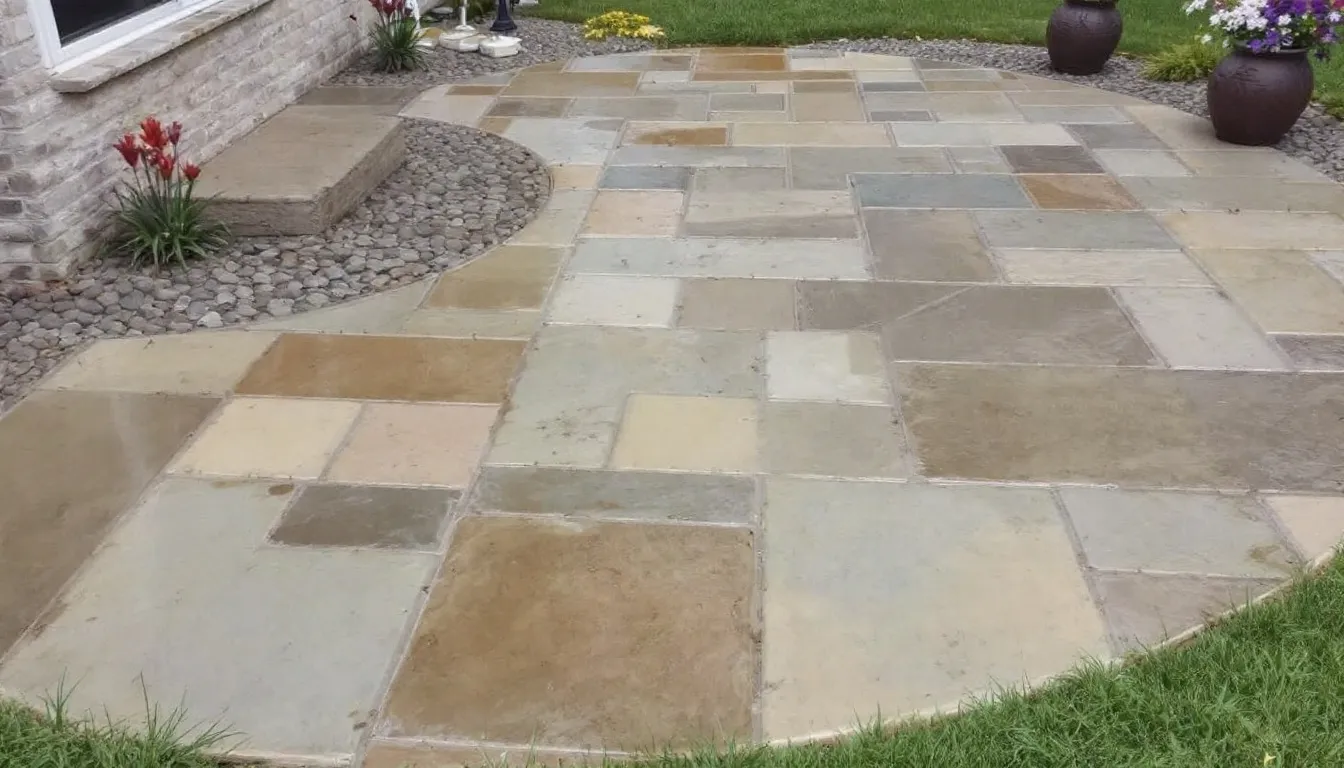
Natural Stone Paving: Complete Guide to Transform Your Outdoor Space
Key Takeaways
- Natural stone paving includes granite, limestone, sandstone, and slate options that provide timeless beauty and exceptional durability for outdoor spaces
- Popular applications include patios, walkways, driveways, and garden paths with various finishes like flamed, brushed, and honed available
- Natural stone offers superior weather resistance, longevity of 50+ years, and increases property value compared to artificial alternatives
- Proper installation requires adequate foundation preparation, drainage considerations, and professional laying techniques for best results
- Maintenance involves regular cleaning, occasional sealing, and prompt repair of any damage to preserve appearance and functionality
Transform your outdoor space into an elegant sanctuary with the timeless appeal of natural stone paving. For centuries, property owners across the world have chosen natural stone to create beautiful, durable surfaces that withstand the test of time while adding warmth and character to their home. Whether you’re planning a new patio, redesigning garden pathways, or upgrading your driveways, natural stone paving offers an extensive range of options to suit every taste and budget.
Unlike porcelain paving or manufactured alternatives, natural stone provides unique textures, colours, and patterns that no two pieces can replicate. This comprehensive guide will help you find the perfect stone solution for your outdoor project, from understanding different stone types to installation and long-term care.
What is Natural Stone Paving?
Natural stone paving refers to the use of quarried stone materials that have been cut and shaped specifically for outdoor flooring applications. These paving slabs are formed over millions of years through geological processes, creating unique mineral compositions that give each stone its distinctive characteristics. As a product, natural stone stands out for its authenticity, durability, and the inherent value it brings to any outdoor space. From the dense, speckled appearance of granite to the smooth, layered texture of slate paving slabs, natural stone offers an unmatched variety of options.
The formation process creates stones with exceptional hardness and durability, making them ideal for outdoor use where they must withstand weather, foot traffic, and temperature changes. Paving stones are available in a range of sizes and thicknesses, allowing you to customize your project to suit specific requirements and applications. Unlike concrete or porcelain alternatives, natural stone develops a beautiful patina over years of exposure to the elements, often becoming more attractive with age.
What sets natural stone apart from manufactured paving products is its authenticity and longevity. While artificial materials may fade or deteriorate within decades, properly installed natural stone can last well over 50 years, making it a practical and economical choice for homeowners seeking long-term value.
Types of Natural Stone for Paving
The extensive range of natural stone types available today provides customers with versatile options to create stunning outdoor spaces. Each stone type offers distinct characteristics in terms of appearance, durability, and suitability for different applications. In addition to standard paving slabs, cobbles are a durable and attractive alternative, especially well-suited for driveways and high-traffic areas due to their variety of sizes and shapes.
Natural stone is also widely used for walling, which plays a key role in creating garden boundaries and decorative features within outdoor spaces.
Granite Paving
Granite stands as one of the most hard wearing options in the natural stone collection. This igneous rock forms deep within the earth under extreme pressure and heat, resulting in exceptional compressive strength ranging from 130-220 MPa. Granite paving slabs can withstand heavy vehicle loads, making them perfect for driveways and high-traffic areas.
The huge range of granite colours includes classic grey, elegant black, warm pink, and distinctive speckled varieties. Recent projects in Dublin and across Ireland have showcased granite’s versatility in both traditional and contemporary settings. Customers appreciate granite’s ability to maintain its appearance even after years of exposure to harsh weather conditions.
Granite’s dense structure makes it highly resistant to staining and requires minimal maintenance compared to softer stones. While the initial price may be higher than other options, granite offers exceptional long-term value through its durability and timeless appeal.
Limestone Paving
Limestone provides a perfect balance of beauty and functionality for outdoor spaces. This sedimentary stone forms naturally over millions of years, creating subtle textures and warm colours that suit both traditional and modern garden designs. Irish limestone, particularly varieties like Kilkenny Blue, has gained recognition worldwide for its exceptional quality and distinctive character.
The natural slip resistance of limestone makes it an excellent choice for patio areas and garden pathways where safety is paramount. Available in colours ranging from warm cream and beige to sophisticated blue-grey tones, limestone complements virtually any architectural style.
Limestone’s slightly porous nature means it benefits from occasional sealing to maintain its appearance and prevent staining. However, this same porosity contributes to its excellent grip properties, making it a practical choice for areas that may become wet.
Sandstone Paving
Sandstone offers remarkable versatility and has been a popular choice for paving projects throughout recent years. This sedimentary stone forms from compressed sand and minerals, creating a naturally textured surface that provides excellent grip and visual interest.
The great range of sandstone colours includes warm buff tones, sophisticated greys, rich reds, and striking rainbow varieties that display multiple hues within single slabs. This variety allows customers to find the perfect match for their specific design vision and existing landscape features.
One of sandstone’s key advantages is its workability during installation. Professional installers find sandstone relatively easy to cut and shape, making it suitable for complex designs and custom applications. The stone’s natural texture eliminates the need for additional surface treatments while providing inherent slip resistance.
Slate Paving
Slate paving slabs bring a distinctive, contemporary look to outdoor spaces while offering exceptional durability and weather resistance. This metamorphic stone forms through the transformation of sedimentary rock under intense pressure, creating its characteristic layered structure and natural split surface.
The range of slate colours extends from classic dark grey and black to unique green and purple Welsh varieties. Each piece displays natural variations in colour and texture that add visual interest and authenticity to any paving project.
Slate’s non-slip properties make it particularly suitable for pool areas, garden paths, and outdoor entertaining spaces. The stone’s resistance to frost damage ensures reliable performance even in harsh winter conditions, making it a dependable choice for year-round outdoor use.
Natural Stone Finishes and Textures
The finish applied to natural stone paving significantly impacts both its appearance and functionality. Understanding the different finishing techniques available helps customers select the right option for their specific needs and aesthetic preferences.
Flamed finish creates a textured surface by applying intense heat to the stone, causing minerals to expand and create a rough, slip-resistant texture. This finish is particularly popular for granite and provides excellent grip for outdoor applications while maintaining the stone’s natural beauty.
Honed finish produces a smooth, matte surface that offers a sophisticated appearance ideal for formal settings. This finish works exceptionally well with limestone and travertine, creating an elegant look that complements traditional and contemporary architecture.
Bush-hammered texture recreates the traditional hand-tooled appearance of historical stonework. This finish provides good traction while adding visual texture and character that suits period properties and heritage projects.
Natural cleft finish preserves the original quarried surface of the stone, showcasing its authentic texture and natural split characteristics. This finish is commonly seen in slate and provides maximum slip resistance along with rustic appeal.
Benefits and Advantages of Natural Stone Paving
Natural stone paving offers numerous advantages that make it a superior choice for discerning property owners. The exceptional durability of natural stone means properly installed paving can last 50 years or more, far exceeding the lifespan of alternative materials.
The unique beauty of natural stone improves with age as weathering creates attractive patina and character. Unlike manufactured materials that may fade or deteriorate, natural stone develops warmth and depth that enhances its visual appeal over time. Natural stone paving also adds a distinctive touch to outdoor spaces, elevating their aesthetic and creating a visually appealing environment.
Each stone piece is completely unique, ensuring no two installations are identical. This individuality allows customers to create truly distinctive outdoor spaces that reflect their personal style and taste.
Natural stone provides excellent weather resistance, withstanding frost, UV exposure, and thermal cycling without degradation. The stone’s thermal mass also helps moderate temperature extremes, creating more comfortable outdoor environments.
From an environmental perspective, natural stone represents a sustainable choice. As a natural material requiring minimal processing, it has low embodied energy compared to manufactured alternatives. Local sourcing further reduces environmental impact while supporting regional economies.
Property values benefit significantly from natural stone installations. Estate agents consistently report that quality stone paving increases home marketability and sale prices, making it a sound financial investment beyond its aesthetic appeal.
The low maintenance requirements of natural stone make it practical for busy homeowners. Regular cleaning and occasional sealing are typically sufficient to maintain its appearance and functionality for decades.
Applications and Design Ideas
Natural stone paving transforms outdoor spaces through versatile applications that enhance both functionality and beauty. The extensive range of available stones and finishes provides endless possibilities for creative design.
Patio Paving
Creating the perfect patio requires careful consideration of stone selection, layout, and integration with surrounding landscape features. Natural stone paving provides an ideal foundation for outdoor entertaining areas, offering durability and beauty that enhances any garden setting.
For larger patios, consider using larger format slabs to create a sense of spaciousness and reduce joint lines. Smaller gardens benefit from more intimate stone sizes that create visual interest without overwhelming the space. The choice of stone colour should complement existing architecture while considering the amount of sunlight the area receives throughout the day.
Popular laying patterns include random layouts that showcase the natural variation in stone shapes and colours, linear arrangements that create contemporary clean lines, and traditional herringbone patterns that add visual texture and movement to the space.
Garden Pathways and Walkways
Well-designed pathways create functional circulation routes while adding structure and beauty to garden spaces. Natural stone stepping stones provide an elegant solution for informal garden paths, allowing plants to grow between stones while maintaining clear walking routes.
Main pathways should typically be at least 1.2 metres wide to allow comfortable passage, while secondary garden routes can be narrower. The choice of stone finish becomes particularly important for pathways, with textured surfaces providing better grip in wet conditions.
Integration with planted areas requires careful planning to ensure proper drainage and prevent root damage to stone foundations. Strategic placement of pathway lighting enhances both safety and visual appeal during evening hours.
For sloped terrain, stepped pathway solutions using natural stone create attractive transitions between different garden levels while providing safe, stable walking surfaces.
Driveways and Vehicle Areas
Designing driveways with natural stone requires attention to structural requirements and stone selection appropriate for vehicle loading. Stone thickness becomes critical, with minimum 40mm depth required for passenger cars and 50mm or greater for heavier vehicles.
Granite and thick limestone slabs offer the best performance for vehicle applications due to their exceptional compressive strength and resistance to surface damage. The stone’s ability to withstand repeated loading cycles and resist staining from automotive fluids makes these materials particularly suitable.
Proper drainage design prevents water accumulation that could lead to foundation problems or winter ice formation. Permeable paving options allow rainwater to infiltrate naturally while maintaining the aesthetic appeal of natural stone.
Edge restraint systems become essential for preventing stone movement under vehicle loads. Professional installation ensures proper foundation preparation and restraint details that maintain pavement integrity over time.
Installation Considerations
Successful natural stone paving installation requires careful attention to ground preparation, drainage, and laying techniques. Proper foundation work ensures long-term performance and prevents common problems like settling, shifting, or water damage.
Ground preparation begins with excavation to appropriate depth, typically 150-200mm for pedestrian areas and 250-300mm for vehicle applications. The excavation must provide uniform bearing and adequate space for sub-base, bedding layer, and stone thickness.
Sub-base requirements typically specify MOT Type 1 aggregate with minimum 100mm depth for pedestrian areas and 150mm for driveways. This material provides structural support and facilitates drainage when properly compacted in lifts.
Bedding layer specifications depend on the installation method chosen. Sharp sand bedding allows for adjustments during laying but requires careful joint filling to prevent movement. Cement mortar bedding provides greater stability but requires more precise initial placement.
Drainage considerations are critical for preventing water damage and frost heaving. Minimum fall of 1:40 gradient directs surface water away from buildings and prevents pooling. Sub-surface drainage may be necessary in areas with poor natural drainage or heavy clay soils.
Professional installation becomes particularly important for large areas, complex patterns, or high-load applications. Experienced installers understand proper techniques for achieving level surfaces, consistent joint spacing, and appropriate edge details.
Essential tools for natural stone installation include mechanical plate compactors, diamond cutting equipment, rubber mallets, string lines, and spirit levels. Quality tools ensure precise installation and professional results.
Maintenance and Care
Proper maintenance preserves the beauty and functionality of natural stone paving while maximizing its lifespan. Understanding the specific care requirements of different stone types helps homeowners develop effective maintenance routines.
Regular cleaning removes dirt, leaves, and organic matter that can cause staining or provide growing medium for weeds and moss. Simple washing with clean water and occasional use of appropriate stone cleaners maintains appearance without damaging the stone surface.
Different stone types require specific cleaning approaches. Limestone and sandstone benefit from pH-neutral cleaners that won’t react with the stone’s mineral content. Granite’s density makes it more resistant to chemical damage but still benefits from gentle cleaning products.
Sealing requirements vary by stone type and porosity. More porous stones like limestone and sandstone typically benefit from sealing every 3-5 years to prevent staining and weather damage. Dense stones like granite may require less frequent sealing or may not need sealing at all in some applications.
Stain removal techniques depend on the type of stain and stone involved. Organic stains from leaves or food typically respond to appropriate cleaning products, while oil-based stains may require specialized treatment. Prompt attention to spills prevents permanent staining.
Weed prevention in joints requires regular maintenance and proper joint filling. Polymeric sand products provide effective weed suppression while allowing some flexibility for thermal movement. Regular inspection and reapplication maintain effectiveness.
Winter care includes proper snow removal techniques that avoid damage to stone surfaces. Plastic shovels prevent scratching, while avoiding chemical de-icers protects stone from potential chemical damage.
Repair techniques for damaged or loose stones typically involve lifting affected areas, checking foundation conditions, and reinstalling with proper bedding and support. Professional assessment may be needed for extensive damage or structural issues.
Cost Considerations and Budgeting
Understanding the costs associated with natural stone paving helps customers make informed decisions and plan realistic budgets for their outdoor projects. While initial costs may exceed alternatives, the long-term value proposition often justifies the investment.
Stone type significantly affects pricing, with sandstone and limestone typically representing the most affordable natural stone options at £30-50 per square metre. Granite commands premium pricing of £45-80 per square metre due to its exceptional durability and processing requirements.
Finish type also impacts cost, with basic sawn finishes being more economical than specialized textures like flaming or bush-hammering. Complex cutting for custom shapes or patterns adds to material and labour costs.
Installation costs typically range from £40-80 per square metre depending on site conditions, access, and complexity. Difficult access, extensive ground preparation, or intricate patterns increase labour requirements and associated costs.
Additional material costs include sub-base aggregate, bedding materials, joint filling products, and edge restraints. These materials typically add £15-25 per square metre to total project costs but are essential for proper installation.
Long-term value comparison favours natural stone over most alternatives. While initial costs may be 50-100% higher than concrete or manufactured pavers, the 50+ year lifespan and minimal replacement needs provide superior lifetime value.
Cost reduction strategies include selecting locally available stone types to minimize transportation costs, choosing standard sizes and finishes, and planning layouts to minimize cutting waste. However, compromising on installation quality to reduce costs typically proves counterproductive.
Proper measurement and planning minimize waste and optimize material ordering. Customers can order paving stones in specific sizes, thicknesses, and quantities to suit their project needs. Professional assistance with quantity calculations ensures adequate material while avoiding excess purchase.
Payment terms vary by supplier, with many offering reasonable financing options for larger projects. Some suppliers provide helpful service including delivery to site, technical support, and installation referrals. Many suppliers also maintain extensive stock of natural stone, aggregates, and paving products for quick delivery and customer convenience.
Frequently Asked Questions
How thick should natural stone paving be for different applications?
For pedestrian areas like patios and garden paths, 20-30mm thickness typically provides adequate durability. Driveways and vehicle areas require minimum 40mm thickness for passenger cars, with 50mm or greater recommended for heavier vehicles or commercial applications. The stone type also influences thickness requirements, with harder stones like granite performing well at minimum thicknesses while softer stones benefit from additional thickness.
Can natural stone paving be laid directly on existing concrete surfaces?
Yes, natural stone can be installed over existing concrete provided the surface is sound, level, and has adequate drainage. The concrete should be cleaned thoroughly and may require surface preparation to ensure proper adhesion of bedding materials. However, the existing concrete must be structurally sound without cracks or settling, and the final surface level must allow proper drainage away from buildings.
What is the best way to clean natural stone paving without damaging it?
Regular cleaning with clean water and a stiff brush removes most dirt and debris effectively. For deeper cleaning, use pH-neutral stone cleaners specifically designed for natural stone. Avoid acidic cleaners like vinegar or lemon juice on limestone and marble, as these can cause permanent etching. Power washing is acceptable for harder stones like granite but should be used carefully on softer stones to prevent surface damage.
Is natural stone paving slippery when wet and how can this be prevented?
Slip resistance varies significantly by stone type and finish. Polished finishes tend to be more slippery when wet, while textured finishes like flamed, riven, or natural cleft provide excellent grip. Slate and sandstone naturally offer good slip resistance due to their texture. For areas where slip resistance is critical, choose stones with textured finishes and avoid polished surfaces in outdoor applications.
How does the cost of natural stone compare to other paving materials over time?
While natural stone has higher upfront costs than alternatives like concrete or block paving, its exceptional longevity often provides better long-term value. Natural stone can last 50+ years with minimal maintenance, while manufactured alternatives may require replacement within 15-25 years. When factoring in replacement costs, maintenance requirements, and the property value enhancement that quality stone provides, natural stone frequently proves more economical over its lifetime.
If you have more questions or need personalized advice for your natural stone paving project, please contact our team for further assistance or to arrange a consultation.




